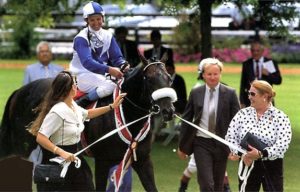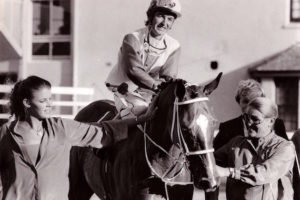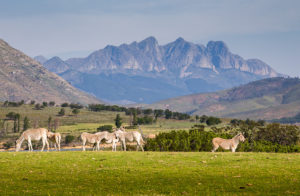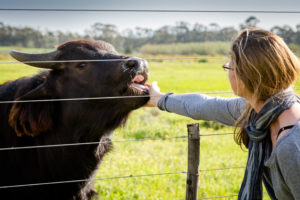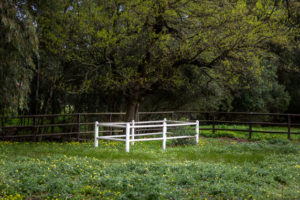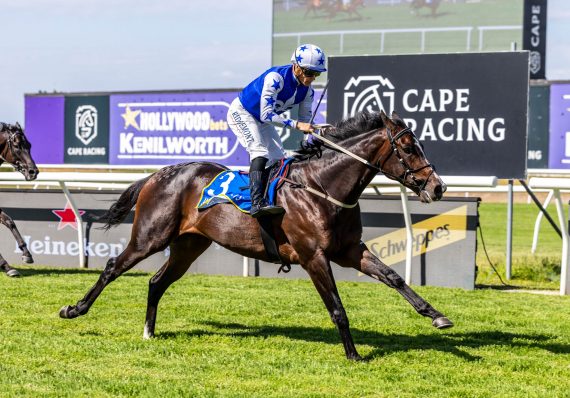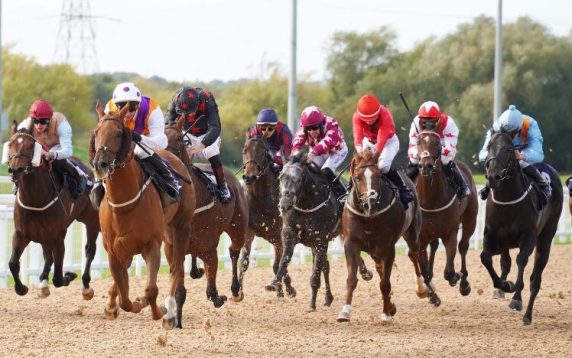Arc-en-Ciel, for so long a force on our breeding landscape, may have closed its stable doors a few years ago, but the name – and the farm – is still very much alive and well, albeit under its new guise as an exotic game farm.
Suzanne Rueda, Shirley Pfeiffer’s daughter, has kindly donated a game drive for up to 6 people with a picnic lunch at the forthcoming Western Cape Equine Trust race day on Saturday, 10 December, so I popped in for a sneak peek.
But first, a little history
Shirley Pfeiffer, who most will associate with the incomparable July and Queen’s Plate winner Flaming Rock was a huge fixture on the South African racing scene in her day. While I never had the privilege of meeting her in person, descriptions usually include words such as lively, intelligent and gregarious, but the word that crops up most is ‘kind’ and stories sketch a mischievous, fun-loving character who lived life to the full with a broad smile on her face.
Shirley was born and bred in Durban. The family fortune came via the Rainbow Chicken empire, founded by her brother, Stanley Methven. Stanley had a vision that chicken would become a staple protein source and started the business on the family farm in Hammarsdale outside Durban in 1960. Shirley had every faith in her brother who is described as a ‘perfectionist’ and a ‘meticulous man’ by those who knew him, and when he asked her to invest in his venture, in characteristic fearless fashion she replied ‘I’m in!’ The rest, as they say, is more or less history.
Shirley married and started a family in Pietermaritzburg, eventually moving to Cape Town in 1967. Racing was in its heyday and as the place to see and be seen and with Shirley loving a party and a bit of gambling, it wasn’t long before she bought her first horse. Suzanne remembers, “It was in the days when horses used to be auctioned off at the end of race meetings. My father bought it for her and it was called Thunder Cloud.” Shirley sent the horse to Chris Snaith, who was doing very well in the Cape Hunt scene and he ran it in the point to point races. “Thunder Cloud was a very good hurdler and that’s how it all started.”
Good horses
Most of Shirley’s horses were trained by Chris Snaith and the families became great friends. Sue Snaith relates, “We had a very special relationship. She was a great lady and we were both very fond of her. She had a lot of good horses, including What A Beauty who was ‘got at’ before a feature race, but won in spite of it. Shirley was so chuffed. She loved that filly. She loved all her horses really. And of course there was Flaming Rock, who was wonderful, but kept bumping the good Millard horses. When she won the July, I don’t think there was a more popular person to win it.”
“We were very young at the time, but she was the backbone of Snaith Racing and was with us through the good and the bad. She started out as a small buyer, then became a big buyer and then a breeder. She absolutely loved her racing.”
Suzanne
Interestingly, although Shirley loved her horses, she had no interest in riding, but her daughter Suzanne more than made up for it. Suzanne explains that her mother couldn’t always make it to the races, so she would frequently travel with the Snaiths, and Sue in particular, for Flaming Rock’s big races. “Sue used to do a lot of work with the Durban string. We were very good friends, so I’d often go up and stay over when Flaming Rock ran. I went to all the Schweppes and was around for a lot of his races. I used to ride work for the Snaiths. Sue and I used to ride all the horses and go to the dunes – it was fun! And I used to ride in the ladies races.”
Shirley’s racing exploits soon led to an interest in breeding. While she originally kept her breeding stock with Derek Southey at The Valley Stud, she’d always wanted her own farm and Chris Snaith helped her find two adjoining wine farms just outside Wellington. She named it Arc-En-Ciel as a nod to their Rainbow Chickens enterprise. Jan Mantel (now running his own operation in Robertson under the Millstream banner) helped build the stud where Shirley’s star, Flaming Rock eventually retired for stud duties. Although he never made it as a commercial stallion, he lived out the rest of his days at Arc-en-Ciel and is buried at a marked grave under one of the great oaks.
The Pfeiffer Kid
It is a little-known fact, that Shirley helped establish and develop the ARO programme with Charles Faull and the Form Organisation. Charles says, “One of the reasons I love racing is that there are people like Shirley in the sport and I count her alongside the grande dames of the SA Turf. She was a wonderful, wonderful woman and we were great friends. I called her the ‘Pfeiffer Kid’.
At the time that Tecla Bluff won the July, Form had been in touch with Mr Lilienfeld to find out whether there were any mares or fillies of the family that could be bought. “Lilienfeld gave us two names, one of which was a mare named Luz Tel. When Tecla Bluff won, I phoned Shirley and said ‘Kid, I’ve got a helluva mare for you’. Shirley said ‘I’m in’. When it came to mating her, I advised Singh, but her other advisers said ‘no, you’ll be breeding a plank to a plank’. Nevertheless, Shirley took my advice and the result was Bluffing.”
“Shirley sold him at auction and he was the last lot of his year at the National Sales. I asked Mr Lilienfeld to look at him and he loved him. He was a tall, backward yearling who would take time, but he advised Graham Beck to buy him. Graham sat around and there was hardly anyone around by the time the horse walked through the ring and he bought him on Lilienfeld’s advice, so the story went full circle,” he says with satisfaction. “Unfortunately he was involved in that tragic transport accident with Millard and lost an eye, but still went on to do good things.”
Change
As a young girl, I saw my first live cover at Arc-en-Ciel and although the details are lost in the mists of time, I still remember the awe and hushed tones in which the stud was mentioned and the sense of occasion I felt driving through the gates, that bright, sunny day.
Years pass and things change. When Shirley passed away, although neither Suzanne nor her brother were particularly passionate about racing, they continued the stud in their mother’s memory with the help of Craig Carey. However, after three decades the racing and breeding game was substantially different to when they’d started out and with the stud not holding its own in terms of commercial success, Suzanne decided to close the doors in 2013.
New rainbows
However, far from closing down, Arc-en-Ciel simply reinvented itself. What I didn’t realise, that day in my childhood, was that the breeding barn I saw, was merely a tiny slice of the farm. Arc-en-Ciel in fact comprises two farms, as Shirley wisely purchased a higher lying adjoining farm for its water.
When I finally returned, on the most gorgeous Boland spring day with ‘plaasvolk’ out in force collecting waterblommetjies and street vendors offering armfuls of arum lilies, there was much that was familiar in the gracious gate and the stately stables and admin buildings. However, safely bundled into the safari vehicle we veered right away from the stables and a short drive later found us in front of a second set of gates, tall game fencing and an altogether different landscape.
Gone the neat, tidy, post and rail fencing of my memory and in its place, equally tidy and neatly ordered (although it took my brain a little while to adjust), game camps, with a variety of – even to my untrained eye – some of the most beautiful exotic game around.
Exotic game
Suzanne’s husband, Fernando explains that what started out as a small enterprise of introducing game onto the farm for their own enjoyment, has evolved into a rare game breeding operation with the addition of exotic, and exotic coloured, game species. Perhaps more importantly / conveniently, it is the first of its kind this close to Cape Town.
One side of the farm contains the exotic and commercial animals, including buffalo, bontebok, sable and roan antelope, black, white and copper springbok, ‘standard’ as well as golden oryx, wildebeest and their golden variant, waterbuck, red hartebeest, eland and giraffe. On one of the highest points of our drive, Suzanne points out a special area where Shirley and Suzanne’s brother both lie buried, with a bird’s eye view of the farm and out across the valley. As the two were somewhat quarrelsome during life, Suzanne has diplomatically buried Shirley’s favourite Doberman between them to keep the peace in the afterlife.
Crossing over to the other side of the farm, we were treated to more wildebeest and, fascinatingly, a small herd of kwagga (yes, I also did a double take, but there is a breeding programme to try and re-establish this once extinct animal). Being given a guided tour by the Rueda’s and farm manager Schutz Marais was a rare treat as they talked us through the metamorphosis of the farm, the trials and tribulations of getting set up for game, acquiring stock of the requisite genetic and aesthetic standards and the fact that they are proving even more successful than they dared hope at breeding game in an area where these animals are not supposed to thrive. There are many challenges, with routine veterinary work being just one as animals need to be rounded up (no small challenge on 1000 hectares) and darted, but as with most things, it is a case of careful management and the team are making steady progress. Numbers will soon be at a level where they can start selling commercially and they are also collaborating with neighbouring estates to offer exclusive game drives.
Highlight
Perhaps the highlight of the trip (although it feels awfully disloyal to choose one incredibly beautiful exotic animal over another) was the orphan buffalo bull calf, Ben. Abandoned by his mother, Ben had to be fostered by one of the local Jersey herd. Despite the fact that buffalo are notoriously temperamental, a calf is a calf and for anyone who has grown up on a farm, the temptation to poke your fingers through the fence and talk to the ‘baby’ (even though he is bigger than his adoptive mom) was simply irresistible. I can safely vouch that there is little to match the experience of having your fingers sucked by a baby buffalo !
Back through the game entrance, we detoured via the old stable block and stopped to pay our respects at Flaming Rock’s grave. Although the stables are empty, they are neatly kept and there are still a few of the stud’s treasured old matrons living out their days in the grassy stud paddocks. Having focussed most of their energies on setting up the game areas over the past few years, Suzanne says that the stables are still on their ‘to do’ list, but the farm is not done with horses yet. Suzanne and Fernando’s daughter Tamara is a keen horsewoman and although she did not inherit her grandmother’s love of racing, she did inherit her determination and competitive spirit and is successfully making her way up the South African show-jumping ranks. With a number of very smart horses in her string, it is nice to know there will be horses at Arc-en-Ciel for many years to come. And for anyone who is bold enough to secure the winning bid on Saturday, I can guarantee an experience that will last a lifetime.



